Analysis of Intercultural Business Competencies at Wilko MAR0386
VerifiedAdded on 2023/06/18
|13
|4160
|106
Report
AI Summary
This report delves into the intercultural business competencies within Wilko, a UK-based retail company, examining how cultural backgrounds correlate within the organization. It highlights the importance of intercultural competence in a globalized environment and how it impacts organizational competitiveness. The report discusses team building development for effective business performance, focusing on Tuckman's model and its stages (forming, storming, norming, performing) to improve employee engagement and productivity. It addresses communication problems that arise in multicultural teams, such as language barriers and cultural differences, and suggests solutions like individual communication and training. The 7 C's of communication (clarity, correctness, conciseness, courtesy, etc.) are presented as principles for effective communication. Finally, the report touches upon Hofstede's cultural model and its relevance to managing diverse teams within Wilko, emphasizing the need for understanding different cultural dimensions to foster a positive work environment. Desklib provides access to similar reports and study resources for students.
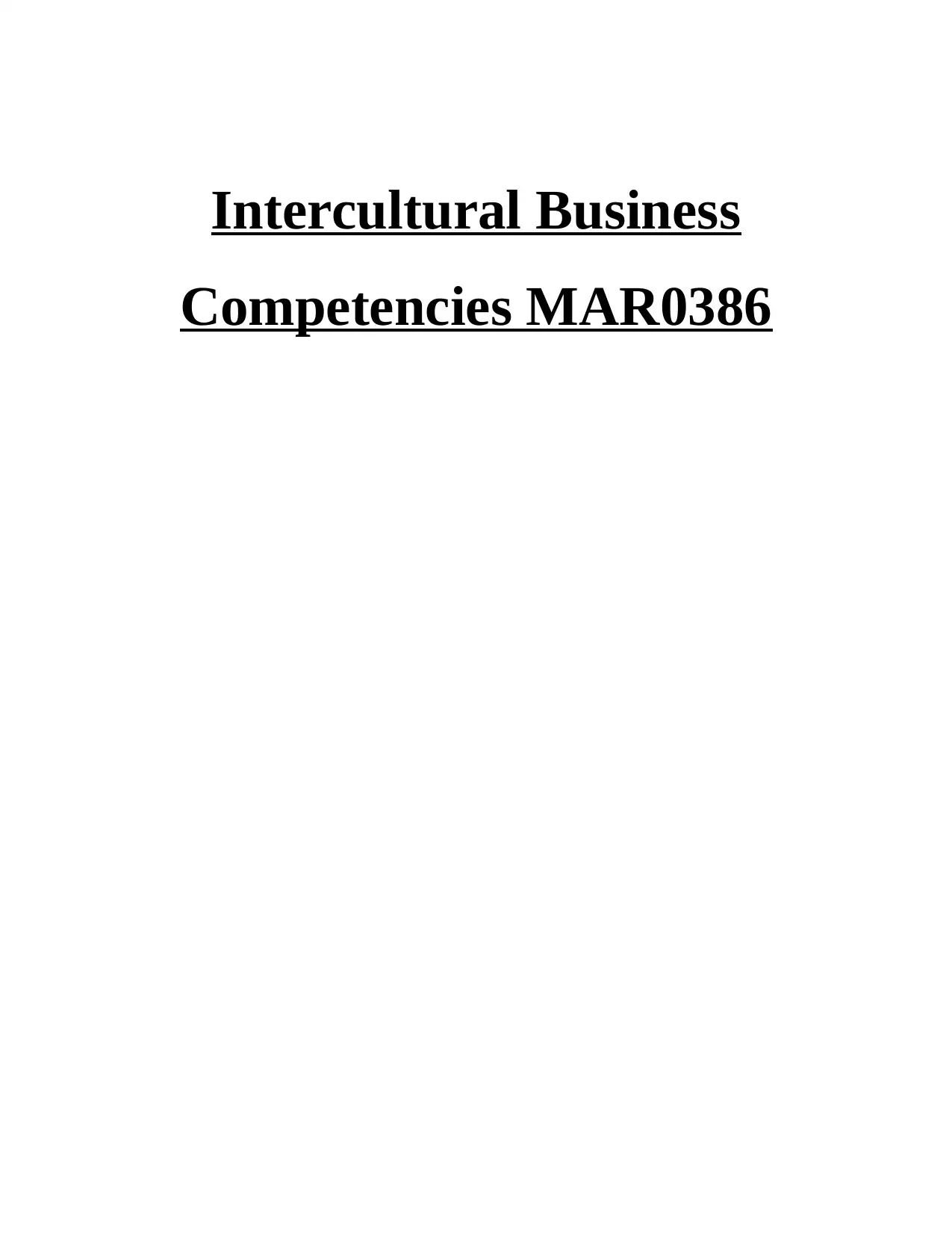
Intercultural Business
Competencies MAR0386
Competencies MAR0386
Paraphrase This Document
Need a fresh take? Get an instant paraphrase of this document with our AI Paraphraser
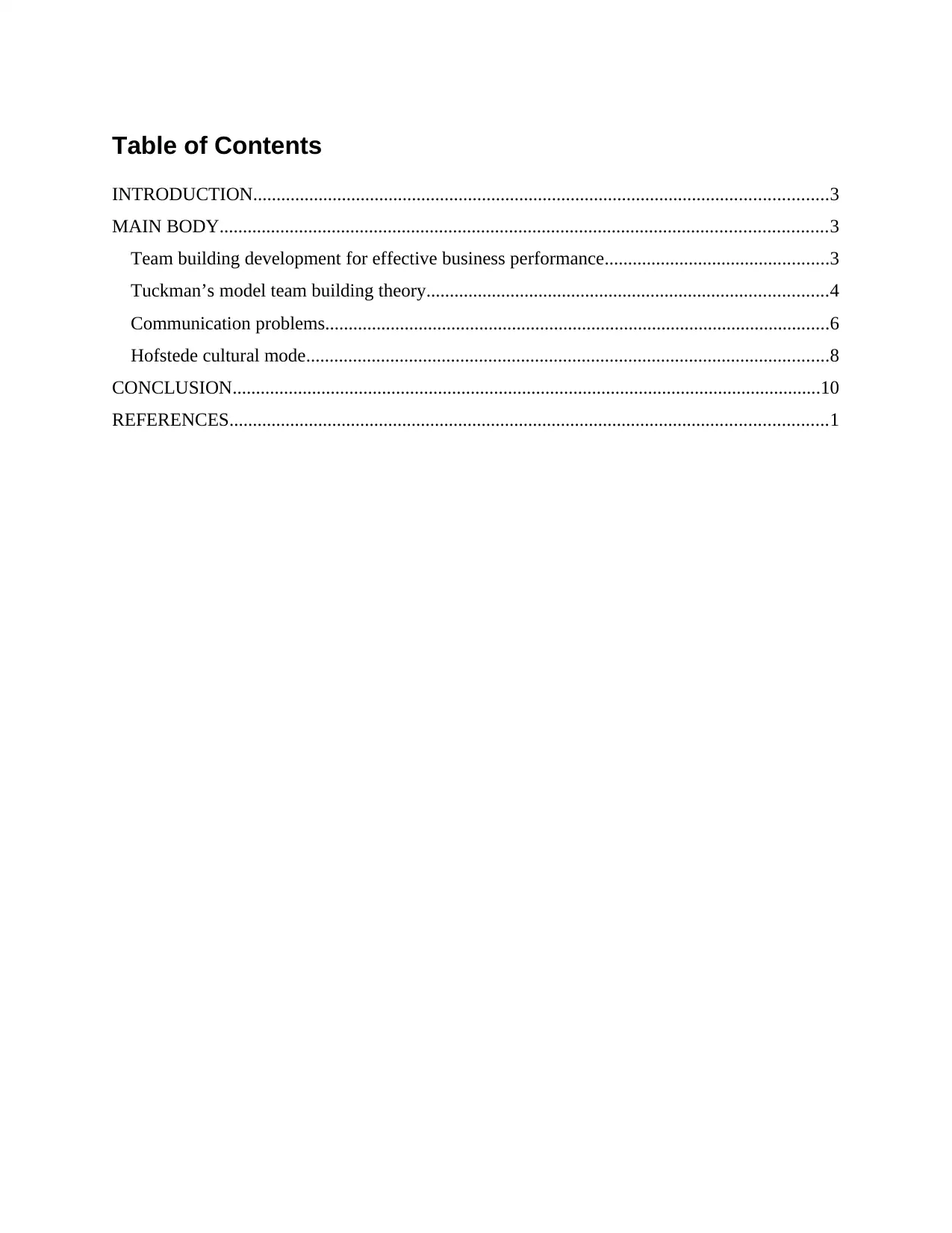
Table of Contents
INTRODUCTION...........................................................................................................................3
MAIN BODY..................................................................................................................................3
Team building development for effective business performance................................................3
Tuckman’s model team building theory......................................................................................4
Communication problems............................................................................................................6
Hofstede cultural mode................................................................................................................8
CONCLUSION..............................................................................................................................10
REFERENCES................................................................................................................................1
INTRODUCTION...........................................................................................................................3
MAIN BODY..................................................................................................................................3
Team building development for effective business performance................................................3
Tuckman’s model team building theory......................................................................................4
Communication problems............................................................................................................6
Hofstede cultural mode................................................................................................................8
CONCLUSION..............................................................................................................................10
REFERENCES................................................................................................................................1
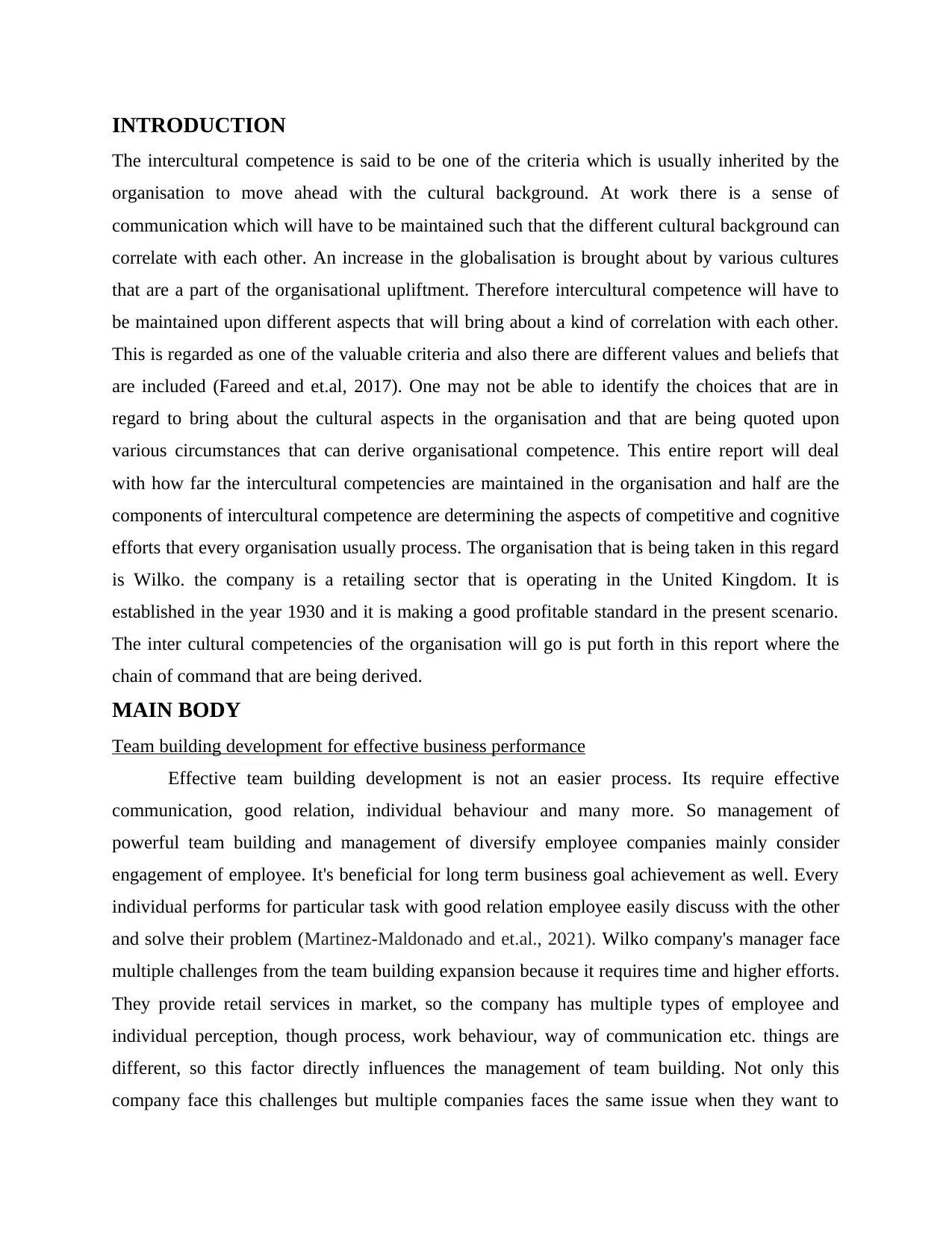
INTRODUCTION
The intercultural competence is said to be one of the criteria which is usually inherited by the
organisation to move ahead with the cultural background. At work there is a sense of
communication which will have to be maintained such that the different cultural background can
correlate with each other. An increase in the globalisation is brought about by various cultures
that are a part of the organisational upliftment. Therefore intercultural competence will have to
be maintained upon different aspects that will bring about a kind of correlation with each other.
This is regarded as one of the valuable criteria and also there are different values and beliefs that
are included (Fareed and et.al, 2017). One may not be able to identify the choices that are in
regard to bring about the cultural aspects in the organisation and that are being quoted upon
various circumstances that can derive organisational competence. This entire report will deal
with how far the intercultural competencies are maintained in the organisation and half are the
components of intercultural competence are determining the aspects of competitive and cognitive
efforts that every organisation usually process. The organisation that is being taken in this regard
is Wilko. the company is a retailing sector that is operating in the United Kingdom. It is
established in the year 1930 and it is making a good profitable standard in the present scenario.
The inter cultural competencies of the organisation will go is put forth in this report where the
chain of command that are being derived.
MAIN BODY
Team building development for effective business performance
Effective team building development is not an easier process. Its require effective
communication, good relation, individual behaviour and many more. So management of
powerful team building and management of diversify employee companies mainly consider
engagement of employee. It's beneficial for long term business goal achievement as well. Every
individual performs for particular task with good relation employee easily discuss with the other
and solve their problem (Martinez-Maldonado and et.al., 2021). Wilko company's manager face
multiple challenges from the team building expansion because it requires time and higher efforts.
They provide retail services in market, so the company has multiple types of employee and
individual perception, though process, work behaviour, way of communication etc. things are
different, so this factor directly influences the management of team building. Not only this
company face this challenges but multiple companies faces the same issue when they want to
The intercultural competence is said to be one of the criteria which is usually inherited by the
organisation to move ahead with the cultural background. At work there is a sense of
communication which will have to be maintained such that the different cultural background can
correlate with each other. An increase in the globalisation is brought about by various cultures
that are a part of the organisational upliftment. Therefore intercultural competence will have to
be maintained upon different aspects that will bring about a kind of correlation with each other.
This is regarded as one of the valuable criteria and also there are different values and beliefs that
are included (Fareed and et.al, 2017). One may not be able to identify the choices that are in
regard to bring about the cultural aspects in the organisation and that are being quoted upon
various circumstances that can derive organisational competence. This entire report will deal
with how far the intercultural competencies are maintained in the organisation and half are the
components of intercultural competence are determining the aspects of competitive and cognitive
efforts that every organisation usually process. The organisation that is being taken in this regard
is Wilko. the company is a retailing sector that is operating in the United Kingdom. It is
established in the year 1930 and it is making a good profitable standard in the present scenario.
The inter cultural competencies of the organisation will go is put forth in this report where the
chain of command that are being derived.
MAIN BODY
Team building development for effective business performance
Effective team building development is not an easier process. Its require effective
communication, good relation, individual behaviour and many more. So management of
powerful team building and management of diversify employee companies mainly consider
engagement of employee. It's beneficial for long term business goal achievement as well. Every
individual performs for particular task with good relation employee easily discuss with the other
and solve their problem (Martinez-Maldonado and et.al., 2021). Wilko company's manager face
multiple challenges from the team building expansion because it requires time and higher efforts.
They provide retail services in market, so the company has multiple types of employee and
individual perception, though process, work behaviour, way of communication etc. things are
different, so this factor directly influences the management of team building. Not only this
company face this challenges but multiple companies faces the same issue when they want to
⊘ This is a preview!⊘
Do you want full access?
Subscribe today to unlock all pages.

Trusted by 1+ million students worldwide
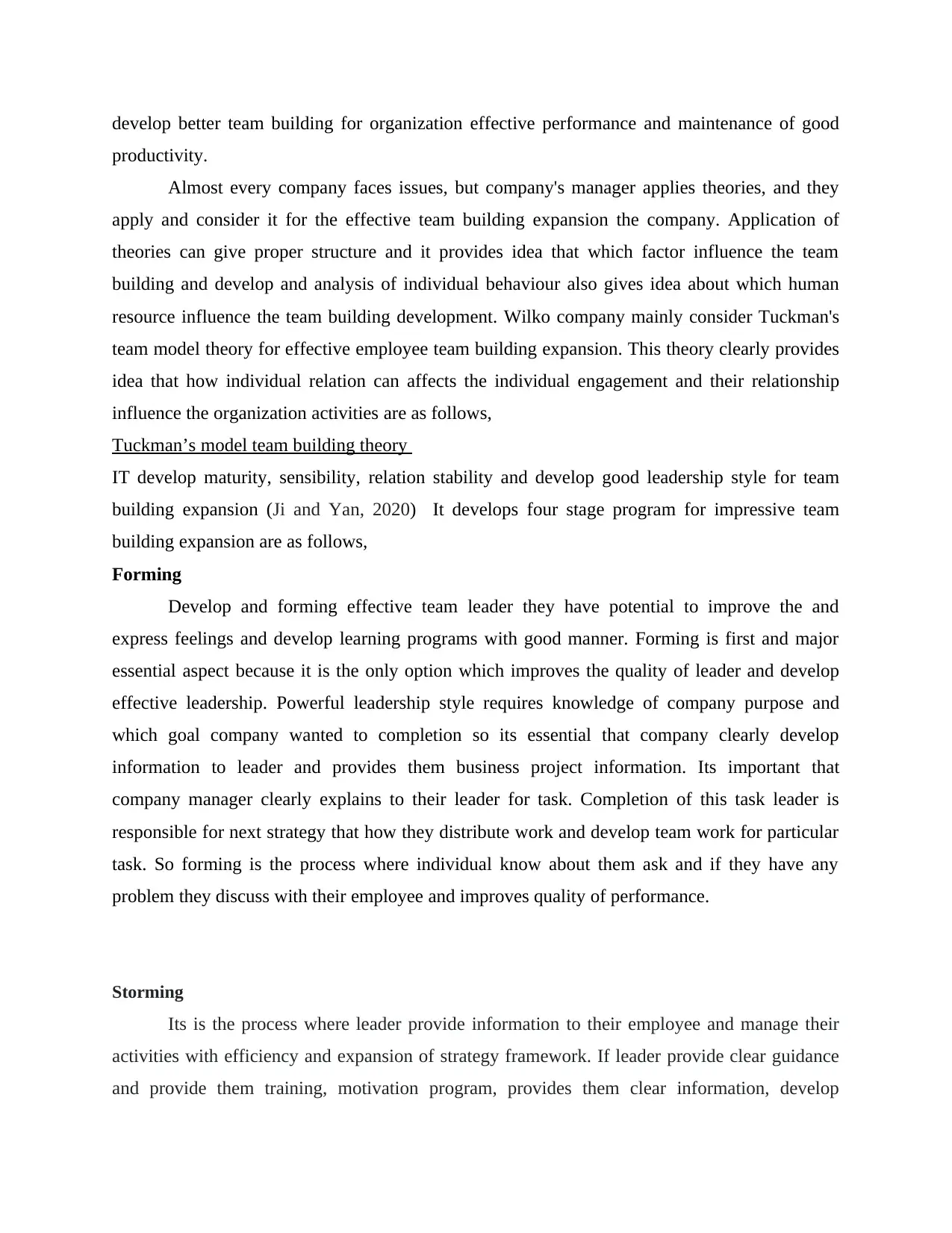
develop better team building for organization effective performance and maintenance of good
productivity.
Almost every company faces issues, but company's manager applies theories, and they
apply and consider it for the effective team building expansion the company. Application of
theories can give proper structure and it provides idea that which factor influence the team
building and develop and analysis of individual behaviour also gives idea about which human
resource influence the team building development. Wilko company mainly consider Tuckman's
team model theory for effective employee team building expansion. This theory clearly provides
idea that how individual relation can affects the individual engagement and their relationship
influence the organization activities are as follows,
Tuckman’s model team building theory
IT develop maturity, sensibility, relation stability and develop good leadership style for team
building expansion (Ji and Yan, 2020) It develops four stage program for impressive team
building expansion are as follows,
Forming
Develop and forming effective team leader they have potential to improve the and
express feelings and develop learning programs with good manner. Forming is first and major
essential aspect because it is the only option which improves the quality of leader and develop
effective leadership. Powerful leadership style requires knowledge of company purpose and
which goal company wanted to completion so its essential that company clearly develop
information to leader and provides them business project information. Its important that
company manager clearly explains to their leader for task. Completion of this task leader is
responsible for next strategy that how they distribute work and develop team work for particular
task. So forming is the process where individual know about them ask and if they have any
problem they discuss with their employee and improves quality of performance.
Storming
Its is the process where leader provide information to their employee and manage their
activities with efficiency and expansion of strategy framework. If leader provide clear guidance
and provide them training, motivation program, provides them clear information, develop
productivity.
Almost every company faces issues, but company's manager applies theories, and they
apply and consider it for the effective team building expansion the company. Application of
theories can give proper structure and it provides idea that which factor influence the team
building and develop and analysis of individual behaviour also gives idea about which human
resource influence the team building development. Wilko company mainly consider Tuckman's
team model theory for effective employee team building expansion. This theory clearly provides
idea that how individual relation can affects the individual engagement and their relationship
influence the organization activities are as follows,
Tuckman’s model team building theory
IT develop maturity, sensibility, relation stability and develop good leadership style for team
building expansion (Ji and Yan, 2020) It develops four stage program for impressive team
building expansion are as follows,
Forming
Develop and forming effective team leader they have potential to improve the and
express feelings and develop learning programs with good manner. Forming is first and major
essential aspect because it is the only option which improves the quality of leader and develop
effective leadership. Powerful leadership style requires knowledge of company purpose and
which goal company wanted to completion so its essential that company clearly develop
information to leader and provides them business project information. Its important that
company manager clearly explains to their leader for task. Completion of this task leader is
responsible for next strategy that how they distribute work and develop team work for particular
task. So forming is the process where individual know about them ask and if they have any
problem they discuss with their employee and improves quality of performance.
Storming
Its is the process where leader provide information to their employee and manage their
activities with efficiency and expansion of strategy framework. If leader provide clear guidance
and provide them training, motivation program, provides them clear information, develop
Paraphrase This Document
Need a fresh take? Get an instant paraphrase of this document with our AI Paraphraser
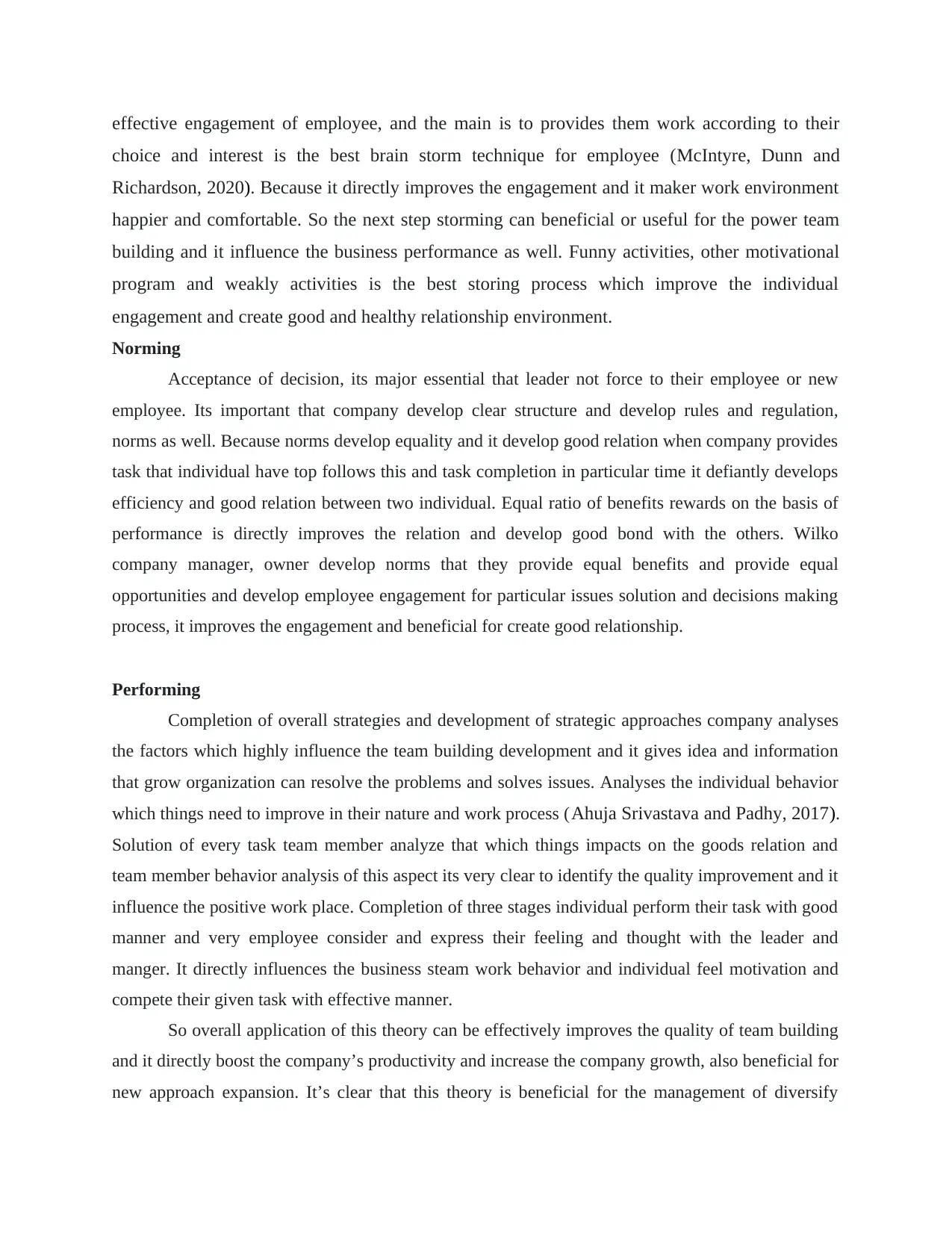
effective engagement of employee, and the main is to provides them work according to their
choice and interest is the best brain storm technique for employee (McIntyre, Dunn and
Richardson, 2020). Because it directly improves the engagement and it maker work environment
happier and comfortable. So the next step storming can beneficial or useful for the power team
building and it influence the business performance as well. Funny activities, other motivational
program and weakly activities is the best storing process which improve the individual
engagement and create good and healthy relationship environment.
Norming
Acceptance of decision, its major essential that leader not force to their employee or new
employee. Its important that company develop clear structure and develop rules and regulation,
norms as well. Because norms develop equality and it develop good relation when company provides
task that individual have top follows this and task completion in particular time it defiantly develops
efficiency and good relation between two individual. Equal ratio of benefits rewards on the basis of
performance is directly improves the relation and develop good bond with the others. Wilko
company manager, owner develop norms that they provide equal benefits and provide equal
opportunities and develop employee engagement for particular issues solution and decisions making
process, it improves the engagement and beneficial for create good relationship.
Performing
Completion of overall strategies and development of strategic approaches company analyses
the factors which highly influence the team building development and it gives idea and information
that grow organization can resolve the problems and solves issues. Analyses the individual behavior
which things need to improve in their nature and work process (Ahuja Srivastava and Padhy, 2017).
Solution of every task team member analyze that which things impacts on the goods relation and
team member behavior analysis of this aspect its very clear to identify the quality improvement and it
influence the positive work place. Completion of three stages individual perform their task with good
manner and very employee consider and express their feeling and thought with the leader and
manger. It directly influences the business steam work behavior and individual feel motivation and
compete their given task with effective manner.
So overall application of this theory can be effectively improves the quality of team building
and it directly boost the company’s productivity and increase the company growth, also beneficial for
new approach expansion. It’s clear that this theory is beneficial for the management of diversify
choice and interest is the best brain storm technique for employee (McIntyre, Dunn and
Richardson, 2020). Because it directly improves the engagement and it maker work environment
happier and comfortable. So the next step storming can beneficial or useful for the power team
building and it influence the business performance as well. Funny activities, other motivational
program and weakly activities is the best storing process which improve the individual
engagement and create good and healthy relationship environment.
Norming
Acceptance of decision, its major essential that leader not force to their employee or new
employee. Its important that company develop clear structure and develop rules and regulation,
norms as well. Because norms develop equality and it develop good relation when company provides
task that individual have top follows this and task completion in particular time it defiantly develops
efficiency and good relation between two individual. Equal ratio of benefits rewards on the basis of
performance is directly improves the relation and develop good bond with the others. Wilko
company manager, owner develop norms that they provide equal benefits and provide equal
opportunities and develop employee engagement for particular issues solution and decisions making
process, it improves the engagement and beneficial for create good relationship.
Performing
Completion of overall strategies and development of strategic approaches company analyses
the factors which highly influence the team building development and it gives idea and information
that grow organization can resolve the problems and solves issues. Analyses the individual behavior
which things need to improve in their nature and work process (Ahuja Srivastava and Padhy, 2017).
Solution of every task team member analyze that which things impacts on the goods relation and
team member behavior analysis of this aspect its very clear to identify the quality improvement and it
influence the positive work place. Completion of three stages individual perform their task with good
manner and very employee consider and express their feeling and thought with the leader and
manger. It directly influences the business steam work behavior and individual feel motivation and
compete their given task with effective manner.
So overall application of this theory can be effectively improves the quality of team building
and it directly boost the company’s productivity and increase the company growth, also beneficial for
new approach expansion. It’s clear that this theory is beneficial for the management of diversify
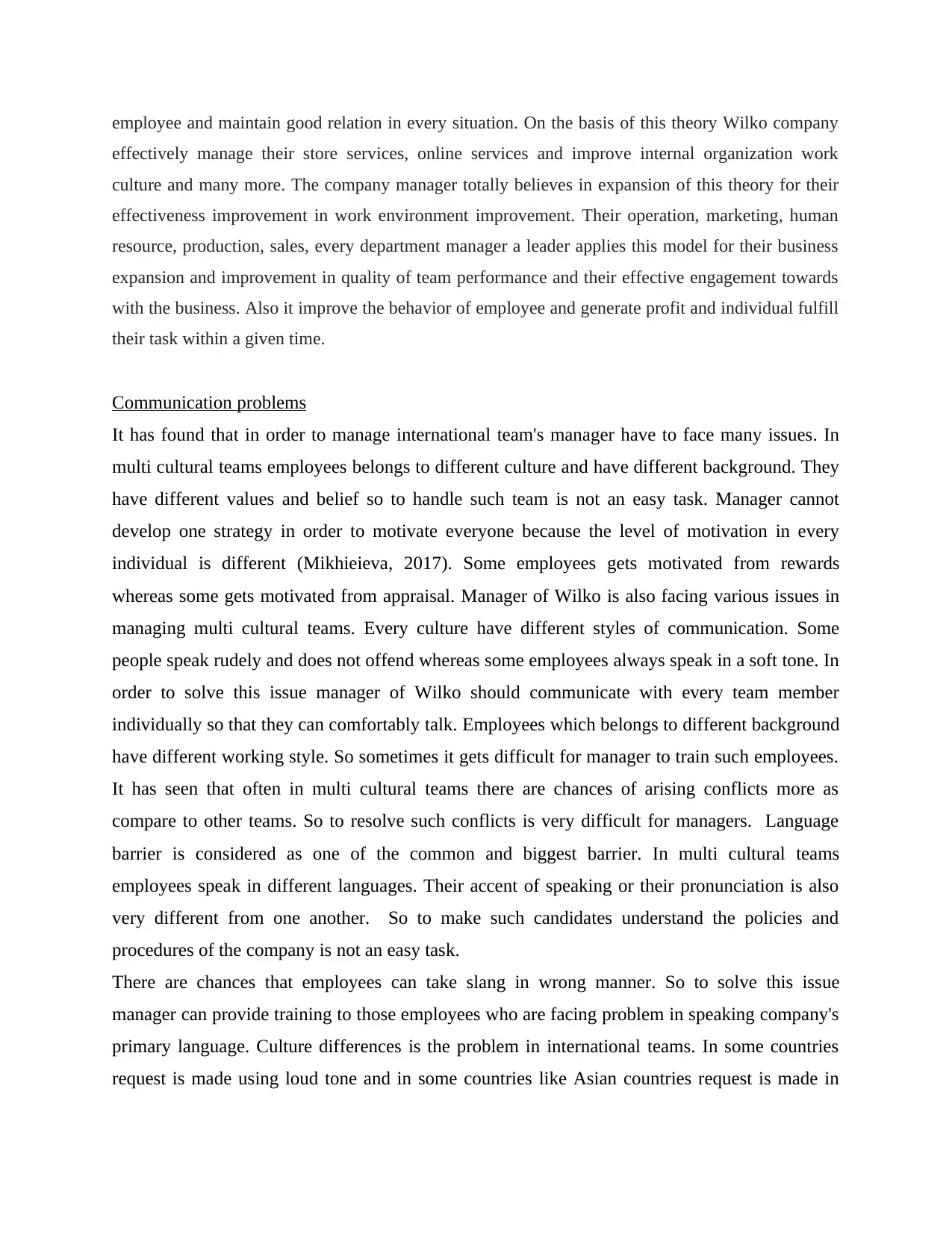
employee and maintain good relation in every situation. On the basis of this theory Wilko company
effectively manage their store services, online services and improve internal organization work
culture and many more. The company manager totally believes in expansion of this theory for their
effectiveness improvement in work environment improvement. Their operation, marketing, human
resource, production, sales, every department manager a leader applies this model for their business
expansion and improvement in quality of team performance and their effective engagement towards
with the business. Also it improve the behavior of employee and generate profit and individual fulfill
their task within a given time.
Communication problems
It has found that in order to manage international team's manager have to face many issues. In
multi cultural teams employees belongs to different culture and have different background. They
have different values and belief so to handle such team is not an easy task. Manager cannot
develop one strategy in order to motivate everyone because the level of motivation in every
individual is different (Mikhieieva, 2017). Some employees gets motivated from rewards
whereas some gets motivated from appraisal. Manager of Wilko is also facing various issues in
managing multi cultural teams. Every culture have different styles of communication. Some
people speak rudely and does not offend whereas some employees always speak in a soft tone. In
order to solve this issue manager of Wilko should communicate with every team member
individually so that they can comfortably talk. Employees which belongs to different background
have different working style. So sometimes it gets difficult for manager to train such employees.
It has seen that often in multi cultural teams there are chances of arising conflicts more as
compare to other teams. So to resolve such conflicts is very difficult for managers. Language
barrier is considered as one of the common and biggest barrier. In multi cultural teams
employees speak in different languages. Their accent of speaking or their pronunciation is also
very different from one another. So to make such candidates understand the policies and
procedures of the company is not an easy task.
There are chances that employees can take slang in wrong manner. So to solve this issue
manager can provide training to those employees who are facing problem in speaking company's
primary language. Culture differences is the problem in international teams. In some countries
request is made using loud tone and in some countries like Asian countries request is made in
effectively manage their store services, online services and improve internal organization work
culture and many more. The company manager totally believes in expansion of this theory for their
effectiveness improvement in work environment improvement. Their operation, marketing, human
resource, production, sales, every department manager a leader applies this model for their business
expansion and improvement in quality of team performance and their effective engagement towards
with the business. Also it improve the behavior of employee and generate profit and individual fulfill
their task within a given time.
Communication problems
It has found that in order to manage international team's manager have to face many issues. In
multi cultural teams employees belongs to different culture and have different background. They
have different values and belief so to handle such team is not an easy task. Manager cannot
develop one strategy in order to motivate everyone because the level of motivation in every
individual is different (Mikhieieva, 2017). Some employees gets motivated from rewards
whereas some gets motivated from appraisal. Manager of Wilko is also facing various issues in
managing multi cultural teams. Every culture have different styles of communication. Some
people speak rudely and does not offend whereas some employees always speak in a soft tone. In
order to solve this issue manager of Wilko should communicate with every team member
individually so that they can comfortably talk. Employees which belongs to different background
have different working style. So sometimes it gets difficult for manager to train such employees.
It has seen that often in multi cultural teams there are chances of arising conflicts more as
compare to other teams. So to resolve such conflicts is very difficult for managers. Language
barrier is considered as one of the common and biggest barrier. In multi cultural teams
employees speak in different languages. Their accent of speaking or their pronunciation is also
very different from one another. So to make such candidates understand the policies and
procedures of the company is not an easy task.
There are chances that employees can take slang in wrong manner. So to solve this issue
manager can provide training to those employees who are facing problem in speaking company's
primary language. Culture differences is the problem in international teams. In some countries
request is made using loud tone and in some countries like Asian countries request is made in
⊘ This is a preview!⊘
Do you want full access?
Subscribe today to unlock all pages.

Trusted by 1+ million students worldwide
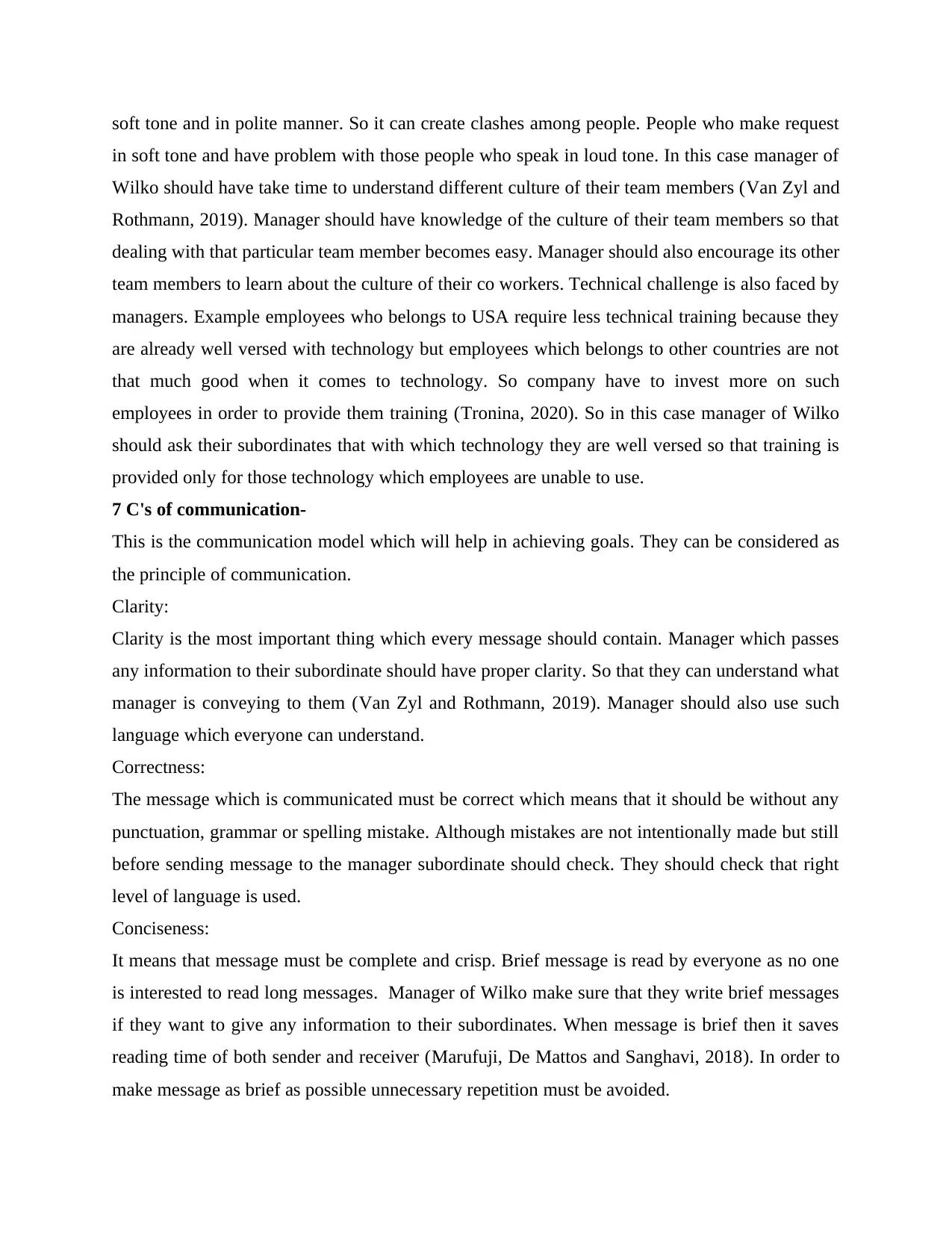
soft tone and in polite manner. So it can create clashes among people. People who make request
in soft tone and have problem with those people who speak in loud tone. In this case manager of
Wilko should have take time to understand different culture of their team members (Van Zyl and
Rothmann, 2019). Manager should have knowledge of the culture of their team members so that
dealing with that particular team member becomes easy. Manager should also encourage its other
team members to learn about the culture of their co workers. Technical challenge is also faced by
managers. Example employees who belongs to USA require less technical training because they
are already well versed with technology but employees which belongs to other countries are not
that much good when it comes to technology. So company have to invest more on such
employees in order to provide them training (Tronina, 2020). So in this case manager of Wilko
should ask their subordinates that with which technology they are well versed so that training is
provided only for those technology which employees are unable to use.
7 C's of communication-
This is the communication model which will help in achieving goals. They can be considered as
the principle of communication.
Clarity:
Clarity is the most important thing which every message should contain. Manager which passes
any information to their subordinate should have proper clarity. So that they can understand what
manager is conveying to them (Van Zyl and Rothmann, 2019). Manager should also use such
language which everyone can understand.
Correctness:
The message which is communicated must be correct which means that it should be without any
punctuation, grammar or spelling mistake. Although mistakes are not intentionally made but still
before sending message to the manager subordinate should check. They should check that right
level of language is used.
Conciseness:
It means that message must be complete and crisp. Brief message is read by everyone as no one
is interested to read long messages. Manager of Wilko make sure that they write brief messages
if they want to give any information to their subordinates. When message is brief then it saves
reading time of both sender and receiver (Marufuji, De Mattos and Sanghavi, 2018). In order to
make message as brief as possible unnecessary repetition must be avoided.
in soft tone and have problem with those people who speak in loud tone. In this case manager of
Wilko should have take time to understand different culture of their team members (Van Zyl and
Rothmann, 2019). Manager should have knowledge of the culture of their team members so that
dealing with that particular team member becomes easy. Manager should also encourage its other
team members to learn about the culture of their co workers. Technical challenge is also faced by
managers. Example employees who belongs to USA require less technical training because they
are already well versed with technology but employees which belongs to other countries are not
that much good when it comes to technology. So company have to invest more on such
employees in order to provide them training (Tronina, 2020). So in this case manager of Wilko
should ask their subordinates that with which technology they are well versed so that training is
provided only for those technology which employees are unable to use.
7 C's of communication-
This is the communication model which will help in achieving goals. They can be considered as
the principle of communication.
Clarity:
Clarity is the most important thing which every message should contain. Manager which passes
any information to their subordinate should have proper clarity. So that they can understand what
manager is conveying to them (Van Zyl and Rothmann, 2019). Manager should also use such
language which everyone can understand.
Correctness:
The message which is communicated must be correct which means that it should be without any
punctuation, grammar or spelling mistake. Although mistakes are not intentionally made but still
before sending message to the manager subordinate should check. They should check that right
level of language is used.
Conciseness:
It means that message must be complete and crisp. Brief message is read by everyone as no one
is interested to read long messages. Manager of Wilko make sure that they write brief messages
if they want to give any information to their subordinates. When message is brief then it saves
reading time of both sender and receiver (Marufuji, De Mattos and Sanghavi, 2018). In order to
make message as brief as possible unnecessary repetition must be avoided.
Paraphrase This Document
Need a fresh take? Get an instant paraphrase of this document with our AI Paraphraser
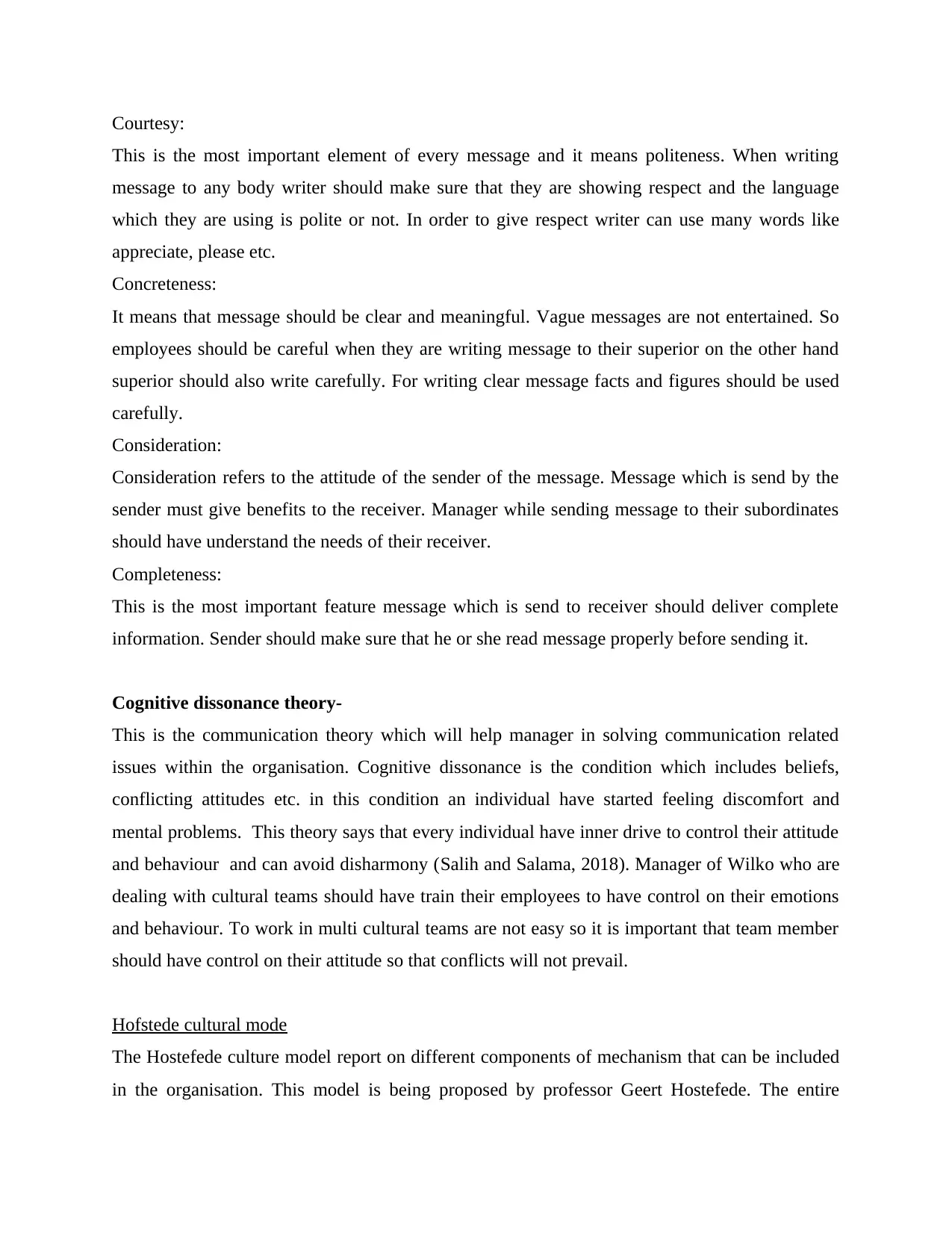
Courtesy:
This is the most important element of every message and it means politeness. When writing
message to any body writer should make sure that they are showing respect and the language
which they are using is polite or not. In order to give respect writer can use many words like
appreciate, please etc.
Concreteness:
It means that message should be clear and meaningful. Vague messages are not entertained. So
employees should be careful when they are writing message to their superior on the other hand
superior should also write carefully. For writing clear message facts and figures should be used
carefully.
Consideration:
Consideration refers to the attitude of the sender of the message. Message which is send by the
sender must give benefits to the receiver. Manager while sending message to their subordinates
should have understand the needs of their receiver.
Completeness:
This is the most important feature message which is send to receiver should deliver complete
information. Sender should make sure that he or she read message properly before sending it.
Cognitive dissonance theory-
This is the communication theory which will help manager in solving communication related
issues within the organisation. Cognitive dissonance is the condition which includes beliefs,
conflicting attitudes etc. in this condition an individual have started feeling discomfort and
mental problems. This theory says that every individual have inner drive to control their attitude
and behaviour and can avoid disharmony (Salih and Salama, 2018). Manager of Wilko who are
dealing with cultural teams should have train their employees to have control on their emotions
and behaviour. To work in multi cultural teams are not easy so it is important that team member
should have control on their attitude so that conflicts will not prevail.
Hofstede cultural mode
The Hostefede culture model report on different components of mechanism that can be included
in the organisation. This model is being proposed by professor Geert Hostefede. The entire
This is the most important element of every message and it means politeness. When writing
message to any body writer should make sure that they are showing respect and the language
which they are using is polite or not. In order to give respect writer can use many words like
appreciate, please etc.
Concreteness:
It means that message should be clear and meaningful. Vague messages are not entertained. So
employees should be careful when they are writing message to their superior on the other hand
superior should also write carefully. For writing clear message facts and figures should be used
carefully.
Consideration:
Consideration refers to the attitude of the sender of the message. Message which is send by the
sender must give benefits to the receiver. Manager while sending message to their subordinates
should have understand the needs of their receiver.
Completeness:
This is the most important feature message which is send to receiver should deliver complete
information. Sender should make sure that he or she read message properly before sending it.
Cognitive dissonance theory-
This is the communication theory which will help manager in solving communication related
issues within the organisation. Cognitive dissonance is the condition which includes beliefs,
conflicting attitudes etc. in this condition an individual have started feeling discomfort and
mental problems. This theory says that every individual have inner drive to control their attitude
and behaviour and can avoid disharmony (Salih and Salama, 2018). Manager of Wilko who are
dealing with cultural teams should have train their employees to have control on their emotions
and behaviour. To work in multi cultural teams are not easy so it is important that team member
should have control on their attitude so that conflicts will not prevail.
Hofstede cultural mode
The Hostefede culture model report on different components of mechanism that can be included
in the organisation. This model is being proposed by professor Geert Hostefede. The entire
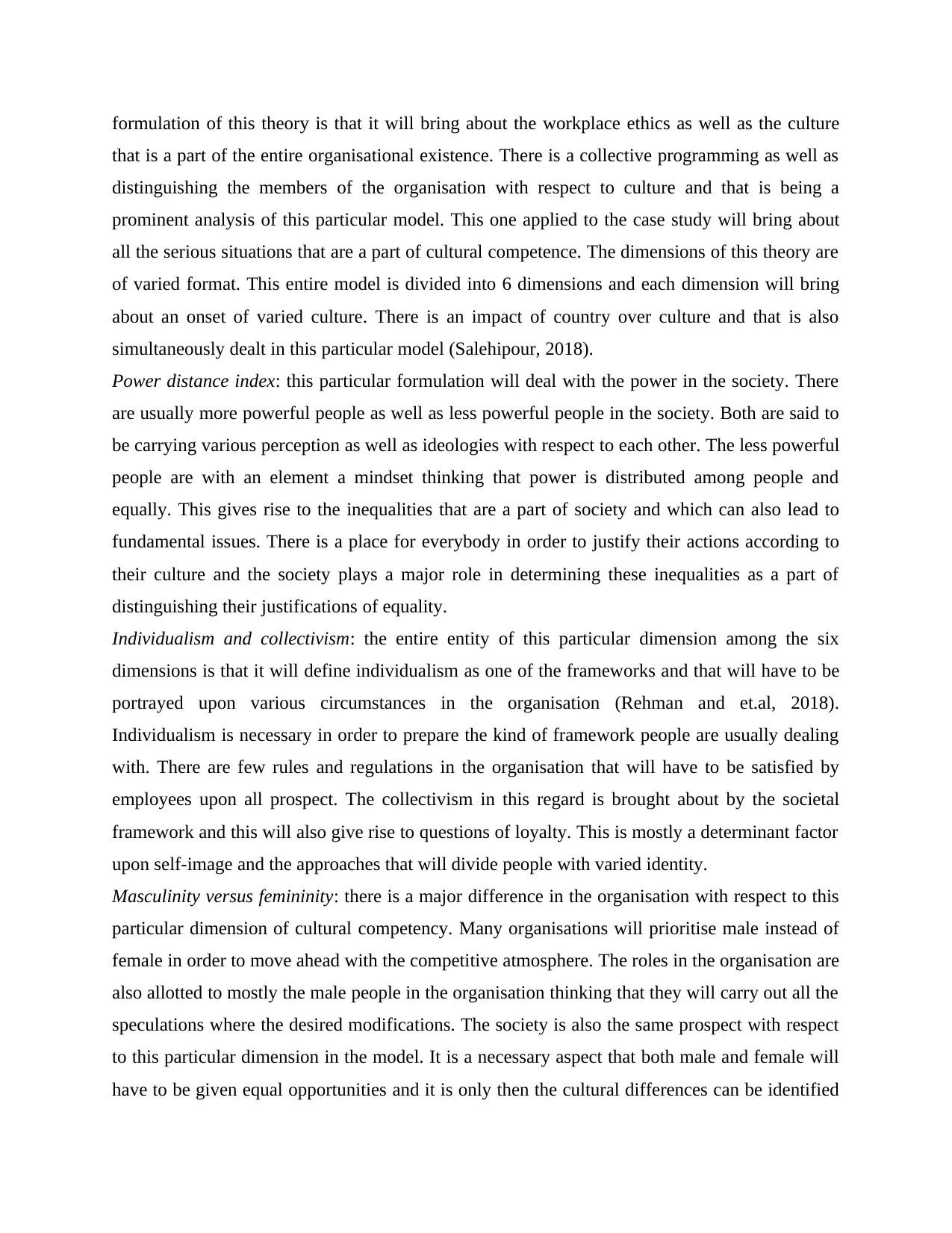
formulation of this theory is that it will bring about the workplace ethics as well as the culture
that is a part of the entire organisational existence. There is a collective programming as well as
distinguishing the members of the organisation with respect to culture and that is being a
prominent analysis of this particular model. This one applied to the case study will bring about
all the serious situations that are a part of cultural competence. The dimensions of this theory are
of varied format. This entire model is divided into 6 dimensions and each dimension will bring
about an onset of varied culture. There is an impact of country over culture and that is also
simultaneously dealt in this particular model (Salehipour, 2018).
Power distance index: this particular formulation will deal with the power in the society. There
are usually more powerful people as well as less powerful people in the society. Both are said to
be carrying various perception as well as ideologies with respect to each other. The less powerful
people are with an element a mindset thinking that power is distributed among people and
equally. This gives rise to the inequalities that are a part of society and which can also lead to
fundamental issues. There is a place for everybody in order to justify their actions according to
their culture and the society plays a major role in determining these inequalities as a part of
distinguishing their justifications of equality.
Individualism and collectivism: the entire entity of this particular dimension among the six
dimensions is that it will define individualism as one of the frameworks and that will have to be
portrayed upon various circumstances in the organisation (Rehman and et.al, 2018).
Individualism is necessary in order to prepare the kind of framework people are usually dealing
with. There are few rules and regulations in the organisation that will have to be satisfied by
employees upon all prospect. The collectivism in this regard is brought about by the societal
framework and this will also give rise to questions of loyalty. This is mostly a determinant factor
upon self-image and the approaches that will divide people with varied identity.
Masculinity versus femininity: there is a major difference in the organisation with respect to this
particular dimension of cultural competency. Many organisations will prioritise male instead of
female in order to move ahead with the competitive atmosphere. The roles in the organisation are
also allotted to mostly the male people in the organisation thinking that they will carry out all the
speculations where the desired modifications. The society is also the same prospect with respect
to this particular dimension in the model. It is a necessary aspect that both male and female will
have to be given equal opportunities and it is only then the cultural differences can be identified
that is a part of the entire organisational existence. There is a collective programming as well as
distinguishing the members of the organisation with respect to culture and that is being a
prominent analysis of this particular model. This one applied to the case study will bring about
all the serious situations that are a part of cultural competence. The dimensions of this theory are
of varied format. This entire model is divided into 6 dimensions and each dimension will bring
about an onset of varied culture. There is an impact of country over culture and that is also
simultaneously dealt in this particular model (Salehipour, 2018).
Power distance index: this particular formulation will deal with the power in the society. There
are usually more powerful people as well as less powerful people in the society. Both are said to
be carrying various perception as well as ideologies with respect to each other. The less powerful
people are with an element a mindset thinking that power is distributed among people and
equally. This gives rise to the inequalities that are a part of society and which can also lead to
fundamental issues. There is a place for everybody in order to justify their actions according to
their culture and the society plays a major role in determining these inequalities as a part of
distinguishing their justifications of equality.
Individualism and collectivism: the entire entity of this particular dimension among the six
dimensions is that it will define individualism as one of the frameworks and that will have to be
portrayed upon various circumstances in the organisation (Rehman and et.al, 2018).
Individualism is necessary in order to prepare the kind of framework people are usually dealing
with. There are few rules and regulations in the organisation that will have to be satisfied by
employees upon all prospect. The collectivism in this regard is brought about by the societal
framework and this will also give rise to questions of loyalty. This is mostly a determinant factor
upon self-image and the approaches that will divide people with varied identity.
Masculinity versus femininity: there is a major difference in the organisation with respect to this
particular dimension of cultural competency. Many organisations will prioritise male instead of
female in order to move ahead with the competitive atmosphere. The roles in the organisation are
also allotted to mostly the male people in the organisation thinking that they will carry out all the
speculations where the desired modifications. The society is also the same prospect with respect
to this particular dimension in the model. It is a necessary aspect that both male and female will
have to be given equal opportunities and it is only then the cultural differences can be identified
⊘ This is a preview!⊘
Do you want full access?
Subscribe today to unlock all pages.

Trusted by 1+ million students worldwide
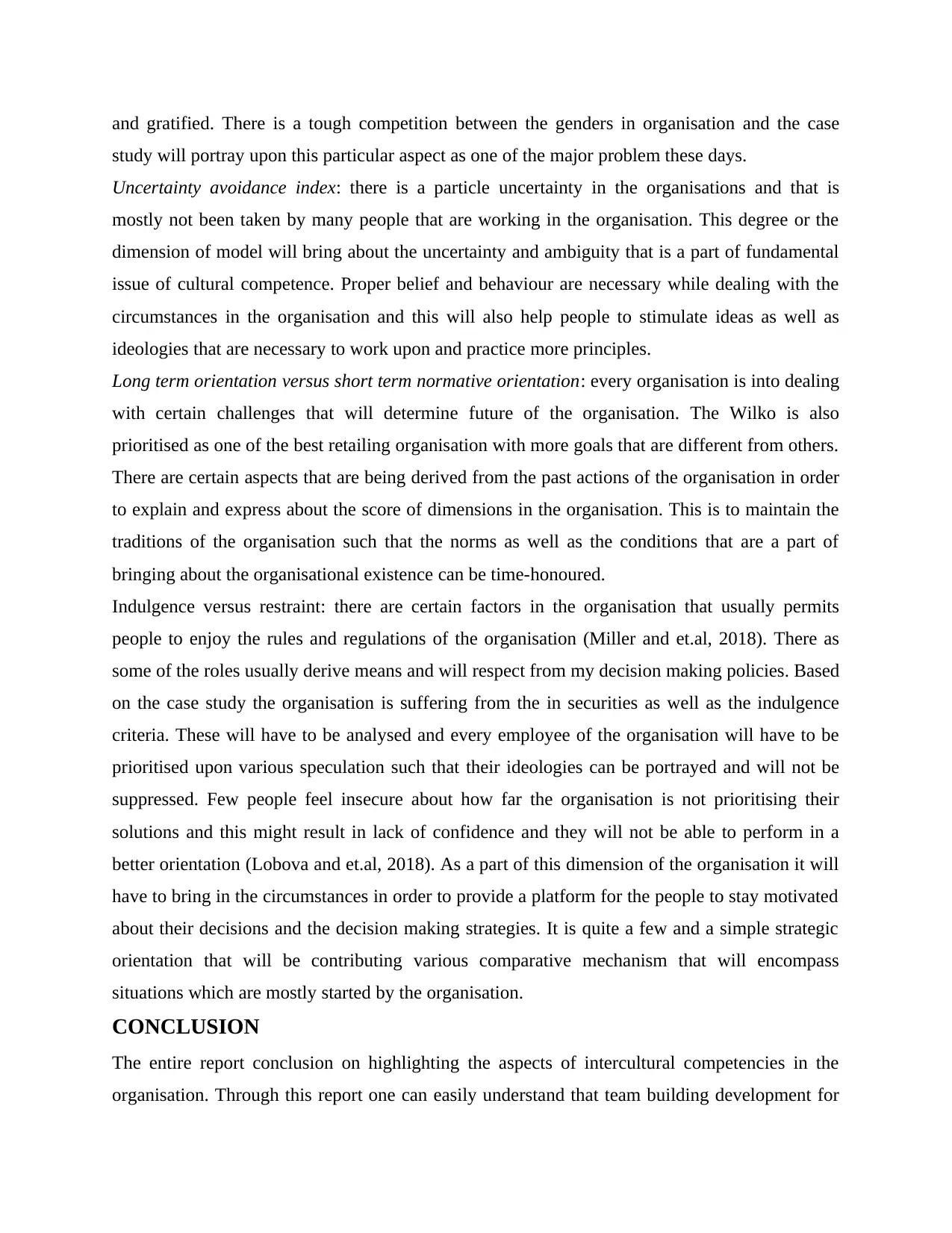
and gratified. There is a tough competition between the genders in organisation and the case
study will portray upon this particular aspect as one of the major problem these days.
Uncertainty avoidance index: there is a particle uncertainty in the organisations and that is
mostly not been taken by many people that are working in the organisation. This degree or the
dimension of model will bring about the uncertainty and ambiguity that is a part of fundamental
issue of cultural competence. Proper belief and behaviour are necessary while dealing with the
circumstances in the organisation and this will also help people to stimulate ideas as well as
ideologies that are necessary to work upon and practice more principles.
Long term orientation versus short term normative orientation: every organisation is into dealing
with certain challenges that will determine future of the organisation. The Wilko is also
prioritised as one of the best retailing organisation with more goals that are different from others.
There are certain aspects that are being derived from the past actions of the organisation in order
to explain and express about the score of dimensions in the organisation. This is to maintain the
traditions of the organisation such that the norms as well as the conditions that are a part of
bringing about the organisational existence can be time-honoured.
Indulgence versus restraint: there are certain factors in the organisation that usually permits
people to enjoy the rules and regulations of the organisation (Miller and et.al, 2018). There as
some of the roles usually derive means and will respect from my decision making policies. Based
on the case study the organisation is suffering from the in securities as well as the indulgence
criteria. These will have to be analysed and every employee of the organisation will have to be
prioritised upon various speculation such that their ideologies can be portrayed and will not be
suppressed. Few people feel insecure about how far the organisation is not prioritising their
solutions and this might result in lack of confidence and they will not be able to perform in a
better orientation (Lobova and et.al, 2018). As a part of this dimension of the organisation it will
have to bring in the circumstances in order to provide a platform for the people to stay motivated
about their decisions and the decision making strategies. It is quite a few and a simple strategic
orientation that will be contributing various comparative mechanism that will encompass
situations which are mostly started by the organisation.
CONCLUSION
The entire report conclusion on highlighting the aspects of intercultural competencies in the
organisation. Through this report one can easily understand that team building development for
study will portray upon this particular aspect as one of the major problem these days.
Uncertainty avoidance index: there is a particle uncertainty in the organisations and that is
mostly not been taken by many people that are working in the organisation. This degree or the
dimension of model will bring about the uncertainty and ambiguity that is a part of fundamental
issue of cultural competence. Proper belief and behaviour are necessary while dealing with the
circumstances in the organisation and this will also help people to stimulate ideas as well as
ideologies that are necessary to work upon and practice more principles.
Long term orientation versus short term normative orientation: every organisation is into dealing
with certain challenges that will determine future of the organisation. The Wilko is also
prioritised as one of the best retailing organisation with more goals that are different from others.
There are certain aspects that are being derived from the past actions of the organisation in order
to explain and express about the score of dimensions in the organisation. This is to maintain the
traditions of the organisation such that the norms as well as the conditions that are a part of
bringing about the organisational existence can be time-honoured.
Indulgence versus restraint: there are certain factors in the organisation that usually permits
people to enjoy the rules and regulations of the organisation (Miller and et.al, 2018). There as
some of the roles usually derive means and will respect from my decision making policies. Based
on the case study the organisation is suffering from the in securities as well as the indulgence
criteria. These will have to be analysed and every employee of the organisation will have to be
prioritised upon various speculation such that their ideologies can be portrayed and will not be
suppressed. Few people feel insecure about how far the organisation is not prioritising their
solutions and this might result in lack of confidence and they will not be able to perform in a
better orientation (Lobova and et.al, 2018). As a part of this dimension of the organisation it will
have to bring in the circumstances in order to provide a platform for the people to stay motivated
about their decisions and the decision making strategies. It is quite a few and a simple strategic
orientation that will be contributing various comparative mechanism that will encompass
situations which are mostly started by the organisation.
CONCLUSION
The entire report conclusion on highlighting the aspects of intercultural competencies in the
organisation. Through this report one can easily understand that team building development for
Paraphrase This Document
Need a fresh take? Get an instant paraphrase of this document with our AI Paraphraser
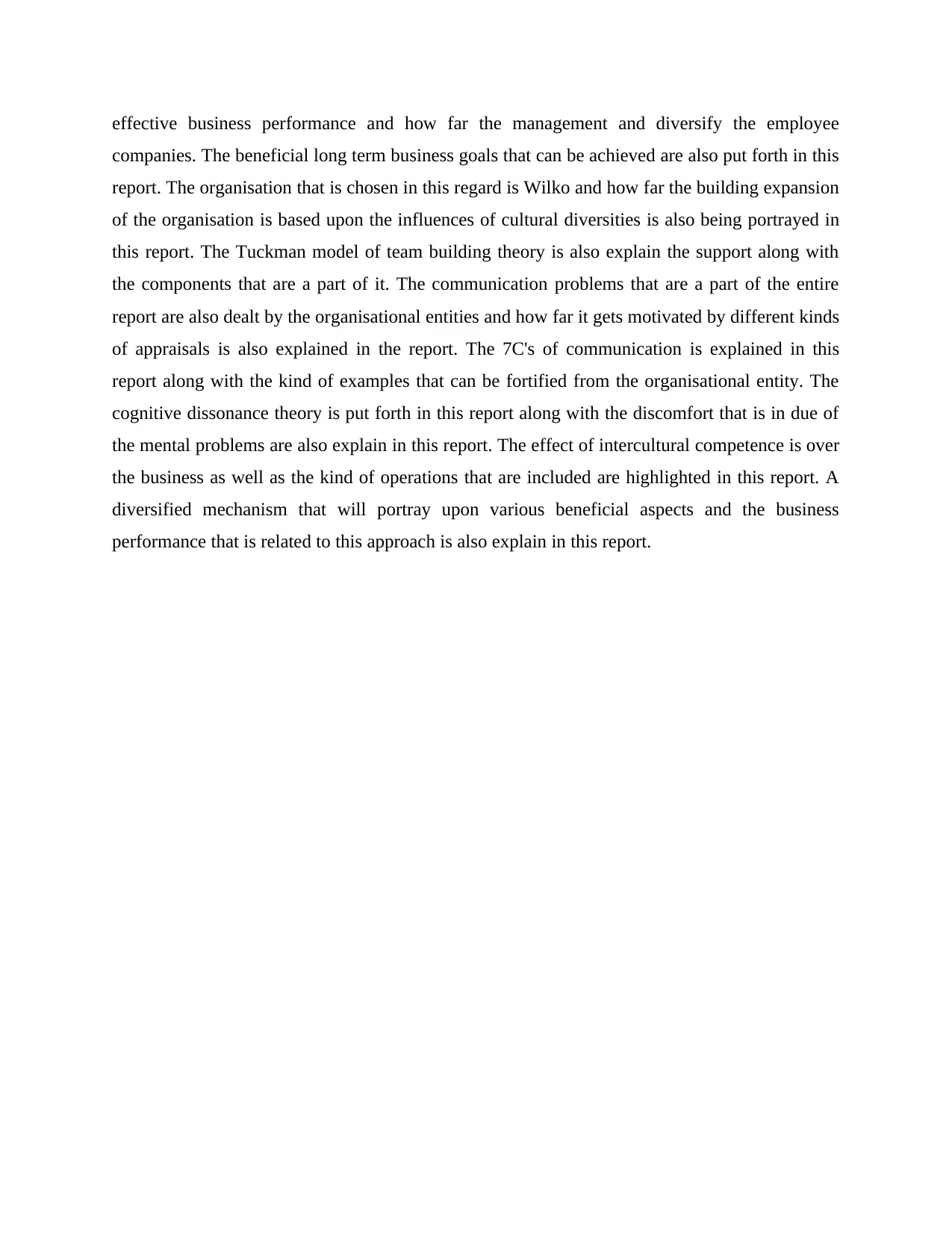
effective business performance and how far the management and diversify the employee
companies. The beneficial long term business goals that can be achieved are also put forth in this
report. The organisation that is chosen in this regard is Wilko and how far the building expansion
of the organisation is based upon the influences of cultural diversities is also being portrayed in
this report. The Tuckman model of team building theory is also explain the support along with
the components that are a part of it. The communication problems that are a part of the entire
report are also dealt by the organisational entities and how far it gets motivated by different kinds
of appraisals is also explained in the report. The 7C's of communication is explained in this
report along with the kind of examples that can be fortified from the organisational entity. The
cognitive dissonance theory is put forth in this report along with the discomfort that is in due of
the mental problems are also explain in this report. The effect of intercultural competence is over
the business as well as the kind of operations that are included are highlighted in this report. A
diversified mechanism that will portray upon various beneficial aspects and the business
performance that is related to this approach is also explain in this report.
companies. The beneficial long term business goals that can be achieved are also put forth in this
report. The organisation that is chosen in this regard is Wilko and how far the building expansion
of the organisation is based upon the influences of cultural diversities is also being portrayed in
this report. The Tuckman model of team building theory is also explain the support along with
the components that are a part of it. The communication problems that are a part of the entire
report are also dealt by the organisational entities and how far it gets motivated by different kinds
of appraisals is also explained in the report. The 7C's of communication is explained in this
report along with the kind of examples that can be fortified from the organisational entity. The
cognitive dissonance theory is put forth in this report along with the discomfort that is in due of
the mental problems are also explain in this report. The effect of intercultural competence is over
the business as well as the kind of operations that are included are highlighted in this report. A
diversified mechanism that will portray upon various beneficial aspects and the business
performance that is related to this approach is also explain in this report.
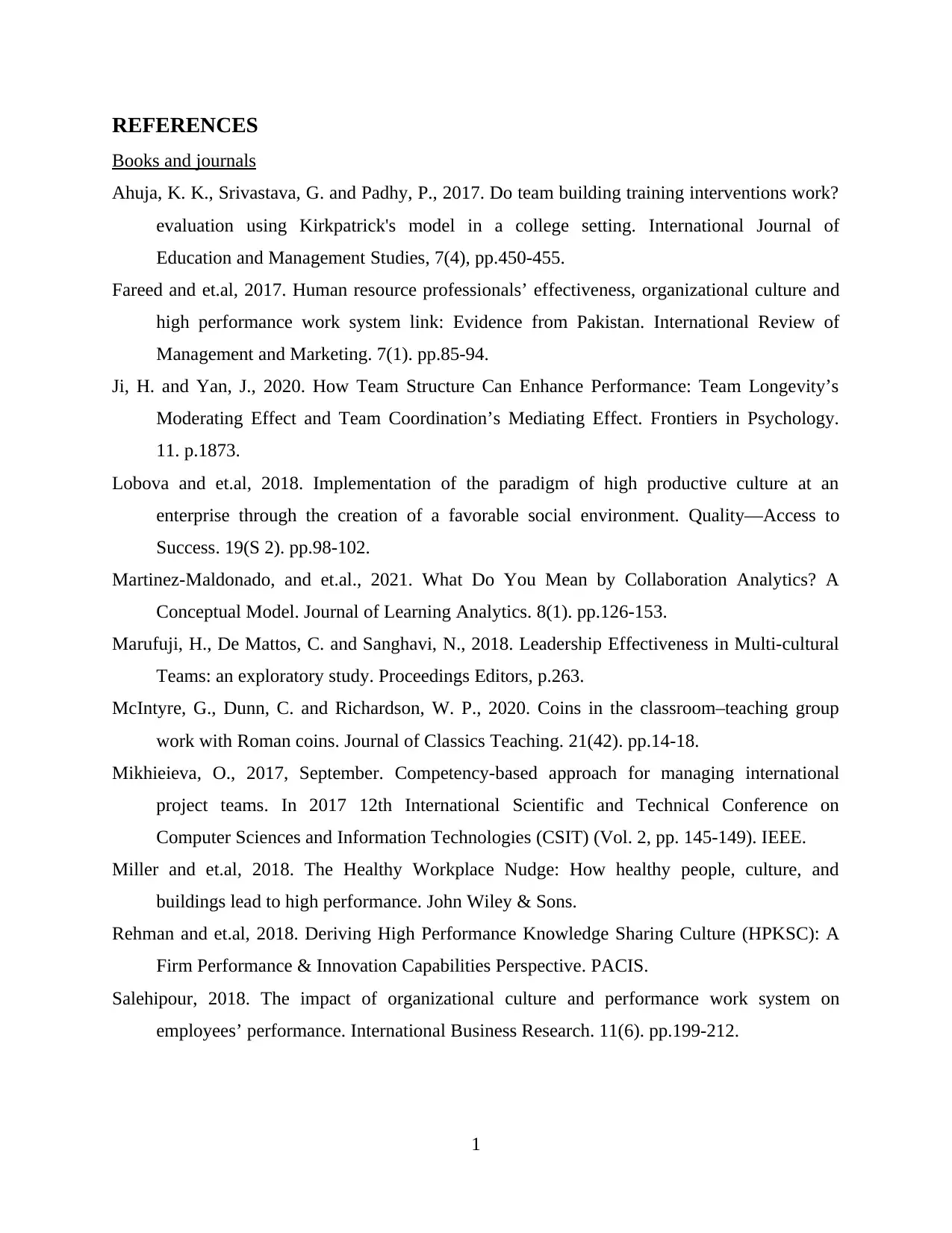
REFERENCES
Books and journals
Ahuja, K. K., Srivastava, G. and Padhy, P., 2017. Do team building training interventions work?
evaluation using Kirkpatrick's model in a college setting. International Journal of
Education and Management Studies, 7(4), pp.450-455.
Fareed and et.al, 2017. Human resource professionals’ effectiveness, organizational culture and
high performance work system link: Evidence from Pakistan. International Review of
Management and Marketing. 7(1). pp.85-94.
Ji, H. and Yan, J., 2020. How Team Structure Can Enhance Performance: Team Longevity’s
Moderating Effect and Team Coordination’s Mediating Effect. Frontiers in Psychology.
11. p.1873.
Lobova and et.al, 2018. Implementation of the paradigm of high productive culture at an
enterprise through the creation of a favorable social environment. Quality—Access to
Success. 19(S 2). pp.98-102.
Martinez-Maldonado, and et.al., 2021. What Do You Mean by Collaboration Analytics? A
Conceptual Model. Journal of Learning Analytics. 8(1). pp.126-153.
Marufuji, H., De Mattos, C. and Sanghavi, N., 2018. Leadership Effectiveness in Multi-cultural
Teams: an exploratory study. Proceedings Editors, p.263.
McIntyre, G., Dunn, C. and Richardson, W. P., 2020. Coins in the classroom–teaching group
work with Roman coins. Journal of Classics Teaching. 21(42). pp.14-18.
Mikhieieva, O., 2017, September. Competency-based approach for managing international
project teams. In 2017 12th International Scientific and Technical Conference on
Computer Sciences and Information Technologies (CSIT) (Vol. 2, pp. 145-149). IEEE.
Miller and et.al, 2018. The Healthy Workplace Nudge: How healthy people, culture, and
buildings lead to high performance. John Wiley & Sons.
Rehman and et.al, 2018. Deriving High Performance Knowledge Sharing Culture (HPKSC): A
Firm Performance & Innovation Capabilities Perspective. PACIS.
Salehipour, 2018. The impact of organizational culture and performance work system on
employees’ performance. International Business Research. 11(6). pp.199-212.
1
Books and journals
Ahuja, K. K., Srivastava, G. and Padhy, P., 2017. Do team building training interventions work?
evaluation using Kirkpatrick's model in a college setting. International Journal of
Education and Management Studies, 7(4), pp.450-455.
Fareed and et.al, 2017. Human resource professionals’ effectiveness, organizational culture and
high performance work system link: Evidence from Pakistan. International Review of
Management and Marketing. 7(1). pp.85-94.
Ji, H. and Yan, J., 2020. How Team Structure Can Enhance Performance: Team Longevity’s
Moderating Effect and Team Coordination’s Mediating Effect. Frontiers in Psychology.
11. p.1873.
Lobova and et.al, 2018. Implementation of the paradigm of high productive culture at an
enterprise through the creation of a favorable social environment. Quality—Access to
Success. 19(S 2). pp.98-102.
Martinez-Maldonado, and et.al., 2021. What Do You Mean by Collaboration Analytics? A
Conceptual Model. Journal of Learning Analytics. 8(1). pp.126-153.
Marufuji, H., De Mattos, C. and Sanghavi, N., 2018. Leadership Effectiveness in Multi-cultural
Teams: an exploratory study. Proceedings Editors, p.263.
McIntyre, G., Dunn, C. and Richardson, W. P., 2020. Coins in the classroom–teaching group
work with Roman coins. Journal of Classics Teaching. 21(42). pp.14-18.
Mikhieieva, O., 2017, September. Competency-based approach for managing international
project teams. In 2017 12th International Scientific and Technical Conference on
Computer Sciences and Information Technologies (CSIT) (Vol. 2, pp. 145-149). IEEE.
Miller and et.al, 2018. The Healthy Workplace Nudge: How healthy people, culture, and
buildings lead to high performance. John Wiley & Sons.
Rehman and et.al, 2018. Deriving High Performance Knowledge Sharing Culture (HPKSC): A
Firm Performance & Innovation Capabilities Perspective. PACIS.
Salehipour, 2018. The impact of organizational culture and performance work system on
employees’ performance. International Business Research. 11(6). pp.199-212.
1
⊘ This is a preview!⊘
Do you want full access?
Subscribe today to unlock all pages.

Trusted by 1+ million students worldwide
1 out of 13
Related Documents
Your All-in-One AI-Powered Toolkit for Academic Success.
+13062052269
info@desklib.com
Available 24*7 on WhatsApp / Email
![[object Object]](/_next/static/media/star-bottom.7253800d.svg)
Unlock your academic potential
Copyright © 2020–2025 A2Z Services. All Rights Reserved. Developed and managed by ZUCOL.


